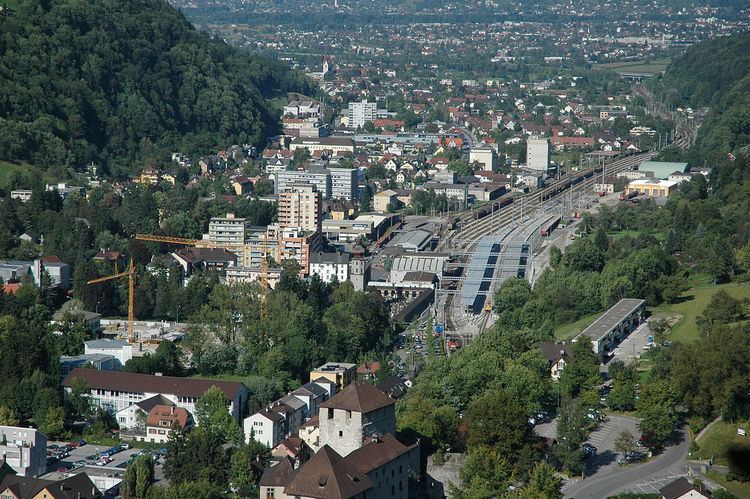Elevation 457 m (AA) Opened 1 July 1872 | Operated by ÖBB | |
 | ||
Location Bahnhofstraße6800 FeldkirchAustria Owned by Austrian Federal Railways (ÖBB) Address Bahnhofstraße 40-42, 6800 Feldkirch, Austria Similar Forst Hilti railway station, Bludenz railway station, Schaan‑Vaduz railway station, Sargans Station, Linz Hauptbahnhof | ||
Feldkirch railway station (German: Bahnhof Feldkirch) serves the city of Feldkirch, in the Feldkirch district of the Austrian federal state of Vorarlberg. Opened in 1872, it forms the junction between the Vorarlberg railway and the Feldkirch–Buchs railway.
Contents
The station is owned and operated by the Austrian Federal Railways (ÖBB).
Location
Feldkirch railway station is situated in Bahnhofplatz, in the northern Feldkirch district of Levis, between the Ardetzenberg and the Känzele.
History
The station was opened on 1 July 1872, together with the rest of the Vorarlberg railway. The original station building was repeatedly extended from 1884, as the Arlberg railway transformed Feldkirch into an international transport hub.
In the 1960s, the original station building was torn down. In early 1969, the new building was put into operation.
Between 1999 and 2001, the station was renovated and rebuilt again, as part of the ÖBB-Bahnhofsinitiative. The renovation work included replacement of the platforms, the pedestrian underpass and the station building.
In 2010, in a survey conducted by the Verkehrsclub Österreich (VCÖ), the station was nominated by the interviewed passengers as the sixth most beautiful railway station in Austria.
Services
Feldkirch is one of Vorarlberg's major railway stations. It also serves as a loading station for the motorail train from Feldkirch to Vienna, Graz and Villach. Additionally, Feldkirch is the border station of the line to Buchs; it is the only Austrian border station adjacent to the Principality of Liechtenstein.
James Joyce
Since Bloomsday 1994, a James Joyce quote has been on display in the station concourse. It emphasizes the special connection between the Irish writer and the city. Joyce paid a visit to Feldkirch in 1932 to see his friend Eugene Jolas. During the visit, he famously said to Jolas, "Over there, on those tracks, the fate of Ulysses was decided in 1915." That is the quote now reproduced, in German translation, in the station concourse.
Joyce had travelled through Feldkirch by train in 1915. Due to World War I, he had been considered an "enemy alien" in his then home town of Trieste, which, at that time, was part of Austria-Hungary. Thanks to influential friends, he had obtained permission to leave Austria-Hungary, with his partner Nora Barnacle and their two shared children, and travel to Zürich. Meanwhile, his brother Stanislaus Joyce was arrested in Trieste and detained until the end of the war.
During border control checks at Feldkirch, the train on which Joyce and Barnacle were travelling was boarded, and passengers inspected by officials; Joyce escaped arrest by a whisker. If Joyce had been arrested then, he would have been unable to write Ulysses in its present form, and that explains his now famous comment to Jolas.
At the end of 2001, the ÖBB replaced a plaque mounted by the Feldkirch culture circle above the ticket counters on Bloomsday 1994 with a particularly clear and conspicuous presentation of the Joycean literary quotation. The ÖBB has thus contributed significantly to the popularization and dissemination of the previously decades-long hidden incident.
Stefan Zweig
In his memoirs The World of Yesterday (German: Die Welt von Gestern), the Austrian writer Stefan Zweig explained that on 24 March 1919 he had been an eye witness at Feldkirch railway station, as Charles I of Austria was deported from the Republic of German Austria into exile in Switzerland:
Upon returning to Austria via the border station at Feldkirch an unforgettable experience stood before me. Even getting out I had noticed a strange unrest in the border guards and policemen. A bell tolled to signal the approach of a train. The policemen stood, all railway officials rushed out of their boxes. Slowly, majestically, the train rolled in, a special kind of train, a Salon train. The locomotive stopped. A motion was palpable through the ranks of those waiting, I still did not know why. Then I saw behind the mirror glass of the coach an erect Emperor Karl, the last Emperor of Austria and his black-clad wife, Empress Zita. I was startled: the last Emperor of Austria, heir to the Habsburg dynasty, which ruled the country for seven hundred years, was leaving his kingdom! As he had refused formally to abdicate, the republic had forced his departure. Now the high serious man stood at the window and saw for the last time the mountains, the houses, the people of his country. ...
